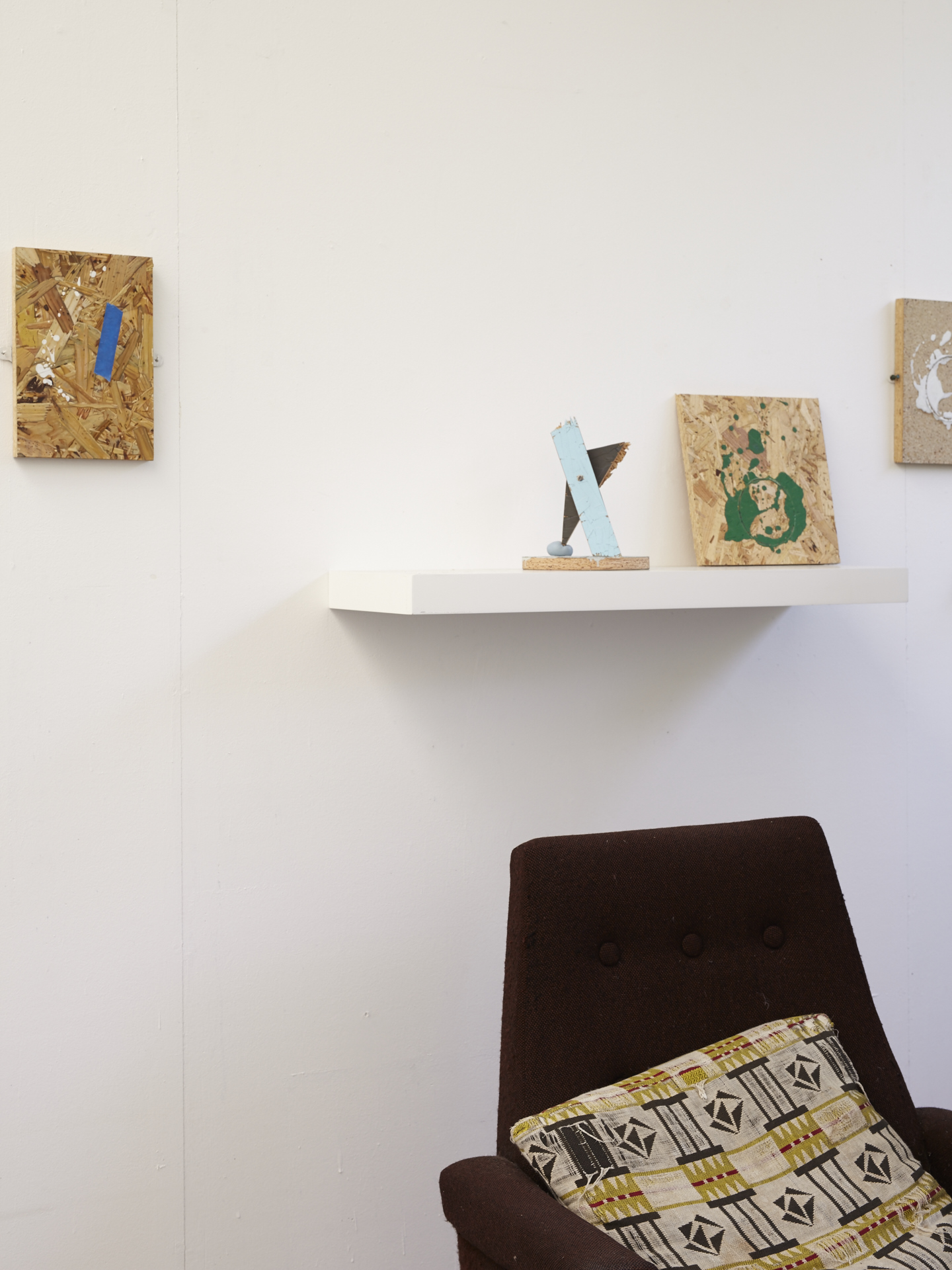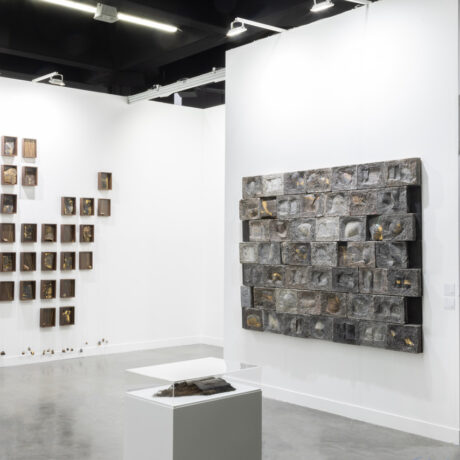
The London-based artist uses techniques such as collage, sculpture and oil painting to painstakingly manufacture abstract assemblages, while still maintaining an element of playful spontaneity. He is currently exhibiting at Sid Motion and dalla Rosa in London, and will be curating a group show at Kurt Schwitters’s Merz Barn in October.
I met the artist at his studio.
Your latest works are a real departure from your earlier, figurative photorealism. How did you make this transition?
It was a gradual process. I was producing paintings from sculptures I made out of Blu Tack and stationary–bits of everyday crap. I was also making collage pieces at the same time; basically producing two strands of work about the same thing. The idea of an art object became more interesting than creating the illusion of pictorial space, so the more conventional photorealism gradually receded.
I’ve focused on recreating the texture of chipboard, beginning with oils and moving on to gesso panels, canvases and paper. I’ve abandoned oils for the moment in favour of more immediate materials, which has been quite liberating. With some of the new pieces, I’m using the coloured paper as a ground, which is both effective and economical as the whole process is much faster. You think the surface is painted, but actually, the only elements that are painted are those that seem unpainted–if you know what I mean. Right now I have all these ideas that I can act on immediately, which I’ve never had before. Everything is much more playful.

You seem to employ a huge amount of experimentation, like you’re constantly manufacturing accidents, whether that is a paint ring, a smudge or a broken piece of wood.
Really it’s all about materiality. Even though what I am creating is a deception, there is still an element of integrity. On the one hand, I’m elevating these objects because I’ve made the effort to bring them together–so it’s all about me–but on the other hand, I’m suggesting they’re exciting in their own right.
It’s just so interesting to try these things out. Some of the marks are collaged or drawn directly onto pieces of board. I’m always looking for new ways to create these illusions. Even in the sculptural works I’ve manufactured the wood splinters and the screws. I mean, they’re still assemblages, they just happen to be made from objects lying around the studio that I’ve already made myself.
I was thinking of having a big show that included all these different works based around the same materials but produced in a variety of ways. People would have to work out which ones were drawing, painting, collage… maybe that will still happen.

You have a very distinct palette. Are you still inspired by the items you were replicating in your earlier work?
That’s a good question. In the past the palette was dictated by the nature of the found objects that I happened to select, such as blue tack or pencil shavings, but these new pieces are much more intuitive. They’re not direct recreations of something that already exists, they’re imagined works. I’ve got lots of off-cuts lying around but none of them are painted in these colours. Industrial hoarding inspires some choices, though I’ve also created a fictional scenario where an outsider artist is randomly painting these pieces of board, which brings in a performative element. I guess I’m trying to have my cake and eat it; I’m being two types of artist at once. These pieces are minimal and abstract, but they’re also works of realism.

Can you tell me about the significance of the titles in this series? You use the term “OSB”, as well as extrapolating on the acronym with a full phrase.
OSB is the name of the chipboard material; it stands for “oriented strand board”. It arrives printed with these letters, so I’ve been coming up with names that incorporate the acronym. Each work has a title and subtitle; the numbered OSB has a link to formality and minimalism, but it’s coupled with something more poetic and prosaic [such as “Observe some banality” or “Our shoulders brushed”], so once again I’m creating a balance between two sides of my practice.
You’ll be curating a group show at Kurt Schwitters’s Merz Barn in the Lake District this autumn. Has the artist been a big influence?
I loved him when I was at college, he seemed quite important then. However he doesn’t have much of a connection to photorealism, so there wasn’t an obvious link for a long time. However, the show at Tate Britain in 2013 brought me back, I knew it was something really special. Since then he’s remained a constant interest, so the opportunity to do something at the Merz Barn is very welcome. I’m curating a group show called Humble as Hell which examines how ideas surrounding scale, subject and material reflect an artist’s ego. The barn is in the middle of nowhere, which is rather apt considering the nature of the exhibition. By hiding it away you’re expecting people to come and make the pilgrimage, it’s both discreet and arrogant.

What about other influences? In your studio you have a lot of different visual references including a postcard of Fabritius’s The Goldfinch.
There will always be artists who are a more constant influence. I’ve always liked Dutch still life–I think my works are all still lifes to a degree. Vermeer is amazing because there’s always a gap in his work that leaves space for you. There’s an ambiguity that can never quite be pinned down, which slightly fussier Dutch art loses. I’m also working with the idea of a light source coming from above in my work, so there’s a connection there.
In terms of how you present your work, do you see this new series as a cohesive whole, as well as functioning on an individual level?
I think they’re all quite flexible really. I’ve had the boards presented in a formal row, as well as in clusters, and I’m always keen to mix the two-dimensional works with sculpture. I’m not overly controlling, so I’ll happily let the gallerists present the works in the way they see fit. Sid Motion and dalla Rosa are both such well-considered spaces, so I know everything is in safe hands.

‘Colour, Order, System’ shows at Sid Motion Gallery until 28 July. ‘CROSS SECTION/04’ is at dalla Rosa Gallery until 29 July. Photographs © Tim Smyth.



